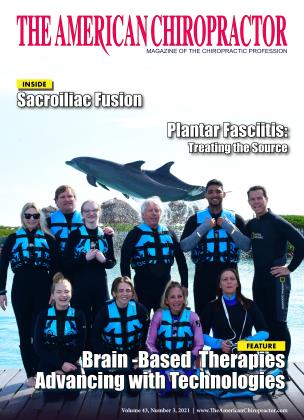Plantar fasciitis is one of the most prevalent causes of foot pain, with millions of Americans experiencing it every year.1 The actual number is likely much higher since many patients attempt to self-diagnose and self-treat their condition without seeking medical care.
However, since mechanical issues are most frequently the source of foot pain, chiropractors are in an ideal position to achieve the best results for patients with this concern. When treating patients with plantar fasciitis, it’s important to think of it as a symptom of unhealthy foot function and structure, rather than the issue itself. By addressing this condition, you can help your patients find relief from their pain while correcting the biomechanical imbalances that contributed to developing plantar fasciitis, which will help prevent its return.
Understanding the mechanics of plantar fasciitis
Plantar fasciitis develops with excessive traction of the fascia, which leads to tearing and inflammation. Wolff’s law dictates that mechanical stresses will influence and cause hard and soft tissue to distort in direct correlation to the amount of stress imposed on it.2 Reduced dorsiflexion of the foot and ankle from a tight Achilles tendon is often present, creating even more stress on the plantar fascia tissues. Stress to the plantar fascia usually results from mechanical causes, such as overpronation with flattening of the arches; trauma; overuse in occupations that involve standing for long periods on hard surfaces; poorly fitting and unsupportive footwear; obesity, leg length inequality (LLI); and arthritis. Even in the short term, pain can impact daily movement, and long-term effects ensue when inflammation of the foot’s ligaments contributes to an unhealthy gait, ineffective weight-bearing, and joint instability.
Evaluating Plantar Fasciitis
To diagnose plantar fasciitis, the patient’s account of their symptoms must be accompanied by a biomechanical exam. This assessment should include evaluation for weakened musculature or tight tissue structures, such as the anterior and posterior tibialis and Achilles tendon. The exam should include:
• Direct palpation of the plantar fascia
• Range-of-motion assessment
• Visual inspection that identifies biomechanical imbalances, such as:
• Postural stability indicator (PSI) test to indicate excessive pronation. This test measures the navicular drop from a non-weight-bearing seated position to a weight-bearing standing position. A drop of over 6 mm indicates that the foot is functioning in a compromised position and lends itself to the chronic stretching of the plantar fascia, as well as affecting the musculature of the lower leg.
• Digital laser exam of both feet using a Foot Levelers Kiosk or scanner that measures all three arches. This produces a scan that shows the foundational imbalances and scores a pronation index. It is especially useful for sharing with patients to educate them about how foot structural instability contributes to their plantar fasciitis.
• Balance tests with and without a tester orthotic that supports all three arches of the foot. Patients should observe a noticeable improvement in their balance and range of motion while they stand on the tester orthotics.
Treating Plantar Fasciitis Through Non-Chiropractic Methods
A multifaceted approach to treatment focused on restoring and maintaining normal structural functionality through ongoing chiropractic care and Foot Levelers custom orthotics can help patients experience a faster recovery and effective, longer-lasting results. It’s extremely important to evaluate the gait cycle once you’ve made your corrections and recommendations. If compensatory patterns resulted from favoring the pain and restricted movements because of subluxation, then some neuromuscular reeducation may be necessary to restore a healthy, symmetrical gait cycle for the patient.
Chiropractic Protocol for Plantar Fasciitis
Following are some ways chiropractors can treat patients with plantar fasciitis:
Adjustments
Regular adjustments to the feet, heels, and ankles lessen pressure on the overly tightened plantar fascia muscle, allowing it to relax and heal itself. Adjustments to the body to help maintain proper posture can correct weight imbalances that overstress the ligaments.
Myofascial Release
Use myofascial release to break up the stressed fibers of the fascia, soft tissues of the foot, and lower leg.
Stretches
Demonstrate stretching and strengthening exercises that patients can do during an office visit or at home. They also can use tools, such as a FootWheel or golf ball, to relax and relieve taut foot muscles.
Custom Orthotics
Scan the feet for underlying structural issues, such as overpronation, and prescribe Foot Levelers custom orthotics to restore healthy foot biomechanics and alignment. Since custom orthotics are built to reflect the specific functional needs of a patient, they can be designed to accommodate heel spurs, which often present with plantar fasciitis. A heel spur correction in the surface of the material under the heel spreads pressure away from the fascial insertion. Custom orthotics should be worn in conjunction with quality footwear that provides proper support for the entire structure of the foot; they are available with custom orthotics built right into them.
In Conclusion
Plantar fasciitis is much more than just a pain issue. Because it’s a symptom of a breakdown in the body’s structural integrity, a knowledgeable and skilled medical provider should monitor its treatment. By partnering with you to address their plantar fasciitis through biomechanical correction, the vast majority of your patients (95%) should respond through conservative care and not require more invasive treatment.3
About the Author
Barbara Meyer is a Chiropractic copywriter based in Roanoke, VA.
References
1. Buchanan, Benjamin K, Kushner, Donald. (2020) Plantar Fasciitis, National Center for Biotechnology Information. https://www.ncbi.nlm.nih.gov/b...
2. Frost HM. Wolff’s law and bone’s structural adaptations to mechanical usage: an overview for clinicians. The Angle Orthod. 1994;64(3): 175-88.
3. Baxter DE. The heel in sport. Clin Sports Med. 1994;13:685-93.
 View Full Issue
View Full Issue









